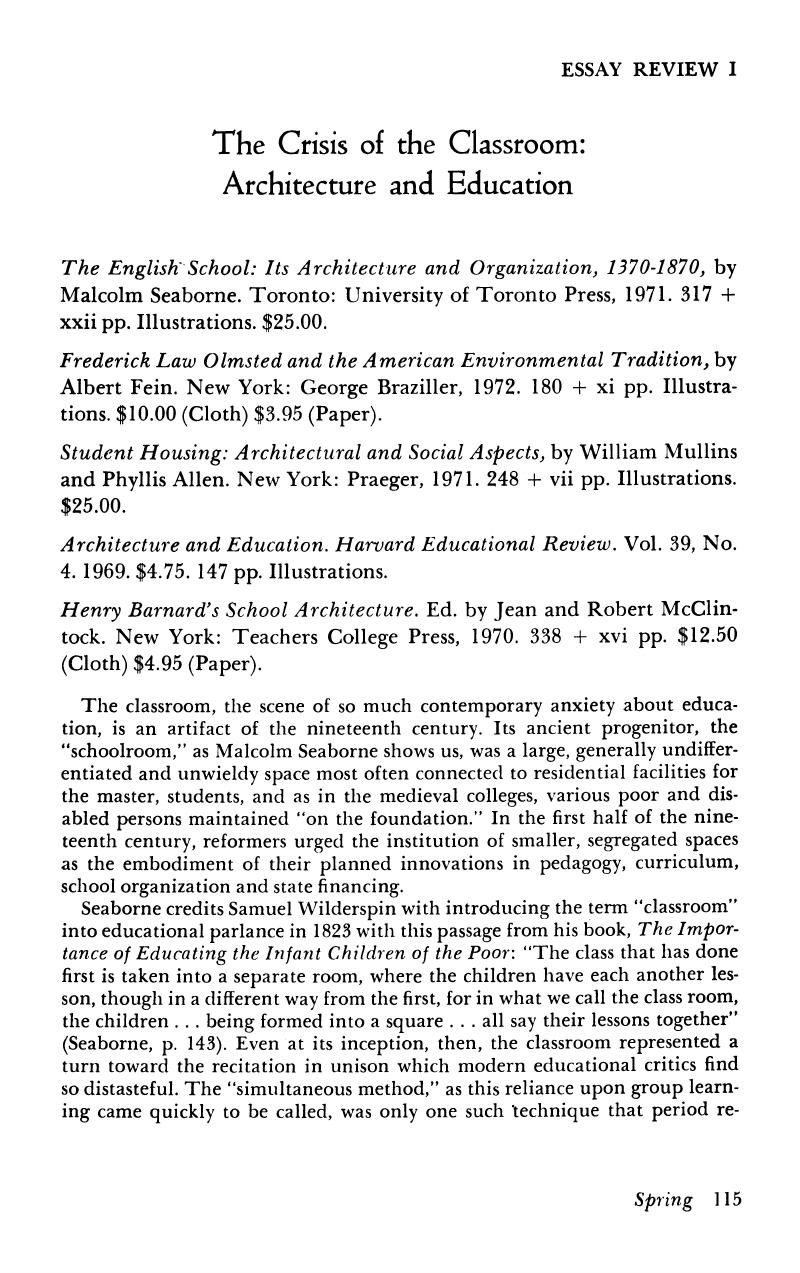Article contents
The Crisis of the Classroom: Architecture and Education
Published online by Cambridge University Press: 24 February 2017
Abstract

- Type
- Essay Review I
- Information
- Copyright
- Copyright © 1973 by New York University
References
Notes
1. I have used the sixth edition (Cincinnati: H. W. Derby and Co., 1854), which richly deserves being reprinted in a facsimile edition today. As part of its Classics in Education series, Teachers College Press has recently issued Henry Barnard's School Architecture, edited by Jean, and McClintock, Robert (New York, 1970). This is based primarily on the second edition (1848), but the editors “have shortened and reorganized it substantially.” Unfortunately, some of the power of the original artifact as a manual has been lost in the process.Google Scholar
2. Barnard, , 6th ed., p. 125. In the McClintocks' edition, this passage appears on p. 87.Google Scholar
3. Brown's manuscript account book is in the New Hampshire Historical Society. Nelson's, Charles B. History of Stratham, New Hampshire, 1631–1900 (Somers-worth, N. H.: New Hampshire Publishing Co., 1965) records the town's vote to build the schoolhouse, and another to provide it with a “brick necessary” in 1836 (pp. 210–211). An old photograph of the building, called the “Stratham Hill School,” appears on p. 212, and shows a handsome, if simple, structure, embellished with a few Greek Revival elements. I would like to thank Caroline Sloat of Old Sturbridge Village for bringing the manuscript to my attention.Google Scholar
4. The account of this development is drawn largely from Morisseau, James J., The New Schools (New York: Van Nostrand Reinhold Company, 1972), pp. 7–8. Morisseau's book contains the plans of many of the most innovative schools built in the United States since the late 1950's. He served for eight years on the staff of Educational Facilities Laboratory, since 1958 the Ford Foundation's agency for architectural improvement. A powerful expression of an older mode of school planning can be found in McQuade, Walter, ed., Schoolhouse (New York: Simon & Schuster, 1958), a book sponsored by the Aluminum Company of America. Also see Roth, Alfred, The New Schoolhouse, rev. ed. (New York: Praeger, 1966), which is almost perfectly analogous (for primary schools) to the Mullins and Allen book on dormitories. Finally, the contrast of American and British versions of the “school without walls” can be seen most effectively in Pearson, Eric, Trends in School Design (New York: Citation Press, 1972), part of a series on Informal Schools in Britain Today. Also see fn. 6 below.Google Scholar
5. For example, the McClintocks begin their introduction to Henry Barnard's School Architecture by claiming that “architectural designs for schools are among the best sources, short of direct observation, for discovering what actually happens in a classroom” (p. 1). But what follows has little to do with an assessment of “what actually happened” in Barnard's schools; it is, rather, a sophisticated essay on how Barnard arrived at “operational efficiency” as a chief design criterion. Part of the difficulty may lie with their too strenuous assumption that “architecture differs from building in that the architect is primarily concerned with the cultural rather than the physical attributes of an edifice” (p. 27). This has a tendency to cloud one's perception of the cultural attributes of structures which don't have “design” or “designers.” Google Scholar
6. By concentrating on the last century and a half, I have certainly not been able to do justice to the breadth of Seaborne's scholarship, but the book is equally valuable for educational historians of earlier periods. The conclusion details the author's methodology and intentions quite well, and should be read first. Although no map of the schools mentioned is included, there is a list of these by county; accompanying the 235 plates, this might make the book one of the best companions on a tour of England, even aside from its value for educational history. Seaborne has continued the story imaginatively beyond 1870 in another book, Primary School Design (London: Routledge & Kegan Paul, 1971). Relying on the fact that well over half the English schools still in use in 1962 (and serving forty-four percent of the students) were built before 1903, this latter volume looks at examples of successive school designs, deduces the educational premises which underlay each, and most significantly, traces the modifications which continuing use has brought. This is a remarkably productive way to generate insights about the relationships between educational planning and school design.Google Scholar
7. Aries, Philippe, Centuries of Childhood: A Social History of Family Life, trans. Baldick, Robert (New York: Alfred A. Knopf, 1962).Google Scholar
8. “Probably the major pressure [for studies in environmental psychology] comes from the change in the sociopolitical climate which has made people feel that they should be part of, or at least, considered in, decision-making processes which affect them….” (Canter, David, People and Buildings—A Brief Overview of Research, Council of Planning Librarians Exchange Bibliography no. 301 [Monticello, Illinois, 1972], p. 2.) This pamphlet provides a good introduction and source list for studies in architectural psychology. Also recommended: Canter, David V., ed., Architectural Psychology: Proceedings of the Conference held at Dalandhui, University of Strathclyde, 28 February-2 March 1969 (London: Royal Institute of British Architects, 1970); Hall, Edward T., The Hidden Dimension (Garden City, N. Y.: Doubleday & Company, 1966); Proshansky, Harold M., Ittelson, William H., and Rivlin, Leanne G., eds., Environmental Psychology: Man and His Physical Setting (New York: Holt, Rinehart and Winston, 1970); Sommer, Robert, Personal Space: The Behavioral Basis of Design (Englewood Cliffs, N. J.: Prentice-Hall, 1969); and Sommer, , Design Awareness (San Francisco: Rinehart Press, 1972). Significant research has been reported in Barker, Roger G., Ecological Psychology: Concepts and Methods for Studying the Environment of Human Behavior (Stanford: Stanford University Press, 1968), and in University of Michigan School Environments Research Project, School Environments Research, 3 vols. (Ann Arbor: University of Michigan, 1965). Google Scholar
- 1
- Cited by




